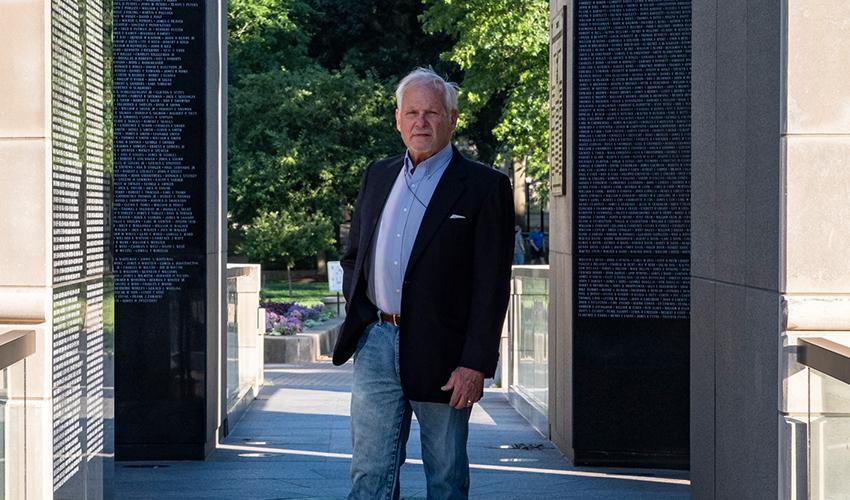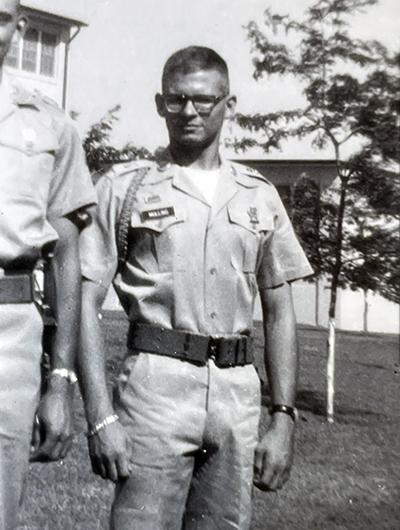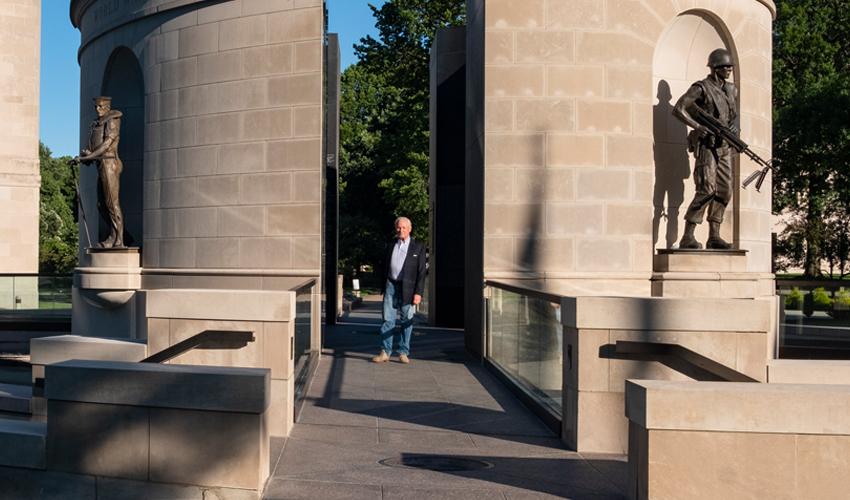
Career of alumnus behind West Virginia Veterans Memorial sculpted by service

As a young man, P. Joseph “Joe” Mullins, MFA ’78, volunteered for the draft in 1960, in the early years of the Vietnam era. That service to country would change the trajectory of his life, culminating in a monumental opportunity to ensure that his fellow West Virginians – those who gave the ultimate sacrifice – would never be forgotten.
“College was a pretty remote idea,” the Charleston, West Virginia resident recalled of entering the workforce after graduating from high school.
Finding himself laid off from construction work one winter and with food in the house running out and his mother in the hospital, a knock at the door from friends who were volunteering for the draft prompted Mullins to join them.
“I knew I could get out in two years and that it would be at least another month until I was called back to work, so I decided to get it out of the way,” Mullins said.
He spent the next two years in the Army infantry and was stationed in Germany during the 1962 Cuban Missile Crisis.
“We were the new kids on the block. They put us right in front of East and West Germany. We didn’t even know the Cuban Missile Crisis was going on,” Mullins remembered. “But they sent 88 doses of morphine to our platoon, so they were expecting serious pain. … Later we were sent into Berlin.”
During the course of his service, Mullins became known for his shooting skills, which he had been developing since his childhood summers spent hunting with his father. He had the best shooting score in his 220-man company and served as a machine gun squad leader.

Mullins had the skills and the respect of his comrades, but being inspected by his lieutenant, “who was in every way my inferior” he said, made him realize something.
“He has a college degree; that’s the only reason he’s in charge. There are certain things you can’t get to just by being good. You need an education,” Mullins said of that moment. “I remember the location. I remember where the sun was in the sky. In that second, I thought I’m going to get a college education. I set my sights on that.”
An aptitude test indicated that a career in architecture aligned well with Mullins’ skills, so he enrolled in Morris Harvey College, known today as the University of Charleston, to study art – the closest major he could find to architecture. That’s where he met Ohio University alumnus James Gibson, MFA ’61, who taught sculpture and opened Mullins’ eyes to a field he didn’t even know existed.
“Sculpture picked me. I didn’t really pick sculpture,” Mullins explained.
While finishing up his undergraduate degree, he took a job in West Virginia’s state planning office. Feeling “only marginally qualified” for the position with his art degree, Mullins started thinking about pursuing an advanced degree.
He and a group from Charleston decided to attend graduate school at Ohio University with Mullins enrolling in the same program Gibson, his former sculpture professor, did: the College of Fine Arts’ MFA in Sculpture.
“It’s a reach when you try to do something else in life,” Mullins said. “You have to sort of remake yourself to a degree. And it helps if you have other people remaking themselves at the same time.”
At OHIO, Mullins found that sense of community.
“Ohio University had a wonderful group of graduate students at the time and a collection of talented and fascinating people,” remembered Mullins, who studied under the late Henry Lin, professor emeritus of ceramics and former dean of the College of Fine Arts. “It’s the only place I’ve ever felt fully accepted, comfortable and with a family.”
Mullins left OHIO with not only his master’s degree but 20 pounds lighter and debt-free – thanks to his GI Bill benefits, a scholarship and creative planning, crafting a tiny house that he lived in near Zaleski State Park and working as a night watchman for a local worm farmer.
“That covered my housing costs, so I was able to get through OU and never borrowed a penny,” he said.
He returned to West Virginia a sculptor and went on to serve as executive director of the Parkersburg Arts Center and open his own art studio in Charleston.
In 1987, Mullins landed the opportunity of a lifetime and a chance to serve – through sculpture – his country once again. Mullins’ design – one of about 180 submitted – was selected for the West Virginia Veterans Memorial, a nearly $4 million tribute to the more than 10,000 West Virginians who served and died in the first four wars of the 20th century.
Constructed on the grounds of the West Virginia Capitol, the two-story oval shaped memorial is surrounded by a reflecting pool. Etched in the black granite of its interior walls are the names of the fallen. Situated in niches on the exterior walls are four 7-foot, 2-inch bronze statues – sculpted by Mullins – that honor each of the conflicts and the branches of the armed services: a World War I infantryman, a World War II sailor, a Korean War airman and a Vietnam War marine.
Committed to building a “world-class monument,” Mullins conducted extensive research while working on the project, talking to veterans, reading books and even traveling to Vietnam.

Ground was broken on the memorial in 1990, and the last of the four bronze statues was installed in 1999. It was work, Mullins noted, that incorporated a multitude of skills – from stone masons and cement finishers to ditch diggers – and even some Ohio University connections.
Lyn Wyatt, MFA ’78, who graduated alongside Mullins, assisted with the memorial’s first two statues. For the bronze casting, Mullins turned to Art Research Enterprises, a Lancaster, Pennsylvania art casting and fabrication company co-founded by OHIO alumni Becky Ault, BFA ’69, MFA ’79, who he attended graduate school with, and Mike Cunningham, BFA ’74.
“They poured with the purest of bronze …, and I think it’s meaningful that the bronze portion of the memorial is an all-OU activity,” Mullins said.
Just as work was completed on the West Virginia Veterans Memorial, Mullins was called upon again – this time to create a bronze statue honoring the state’s female veterans. He completed that work in 2003, but disagreements over the statue’s attire and location delayed its installation until 2010.
Today, the West Virginia Female Veterans Memorial sits on the Capitol grounds, facing the West Virginia Veterans Memorial; its 7-foot, 2-inch statue placed atop a 9-foot base, making it the same height as its counterpart servicemen.
Now largely retired, Mullins looks back on his career – a journey, he described, as one of “fame over fortune.”
The creator of the West Virginia Veterans Memorial – the largest piece of public art in Charleston with a nine-year haul to completion – Mullins is also the creator of the city’s smallest work of public art, crafted in mere minutes.
“Oh, my greatest work!” Mullins quipped, referring to “Mortar Man,” a 4-inch by 2-inch sculpture he quietly created from extra concrete while working on a restoration project in downtown Charleston. Tucked on a ledge between two buildings, “Mortar Man” sat there a couple years before anyone even noticed him. Today, “Mortar Man” is one of the city’s 10 major attractions.
But just a few miles away is the masterpiece that Mullins will forever be remembered for.
“Each of those people named on the Veterans Memorial was the most important person in somebody’s life and taken in the prime of their life,” said Mullins, who has heard the stories of many of the fallen when family members reached out to him to make sure their loved one was being included on the memorial. “I thought they deserved something that indicated that there’s a nation and state grateful for their service, and they need to be recognized for their sacrifice and for upholding the oath they took—to defend the Constitution against all enemies foreign and domestic. Without the Constitution, America is not America.”
